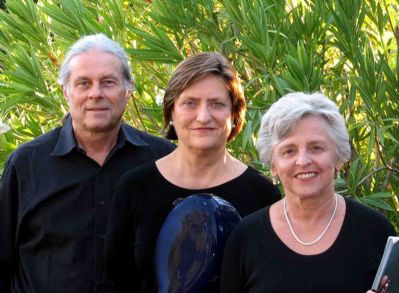|
Symphony
FROM THE NEW WORLD TO THE OLD WORLD
by Peter Lert
Saturday, June 14, 2025
Chamber
MC2 DUO RECITAL CLOSES 222'S SEASON
by Terry McNeill
Saturday, June 14, 2025
Choral and Vocal
CANTIAMO SONOMA'S LUSCIOUS A CAPELLA SINGING IN SEASON ENDING CONCERT
by Pamela Hicks Gailey
Sunday, June 8, 2025
Symphony
SRS SEASON ENDS WITH RESOUNDING TA-TA-TA-BANG
by Terry McNeill
Sunday, June 1, 2025
Symphony
YOUTHFUL VIRTUOSITY ON DISPLAY AT USO'S MAY CONCERTS
by Peter Lert
Saturday, May 17, 2025
Symphony
MYSTICAL PLANETS AND LIVELY GERSHWIN ORTIZ AT FINAL SRS CONCERT
by Peter Lert
Sunday, May 4, 2025
Symphony
VSO'S CONCERT MUSIC OF TIME, MUSIC OF PLACE
by Peter Lert
Sunday, April 27, 2025
VOCAL ELEGANCE AND FIRE AT THE 222'S RECITAL APRIL 26
by Pamela Hicks Gailey
Saturday, April 26, 2025
CANTIAMO SONOMA SINGS AN INSPIRED GOOD FRIDAY MOZART REQUIEM CONCERT
by Pamela Hicks Gailey
Friday, April 18, 2025
DRAMATIC SHOSTAKOVICH SYMPHONY CLOSES PHILHARMONIC'S 25TH SEASON
by Terry McNeill
Sunday, April 13, 2025
|
 |
 The Sequoia Trio |
AND SEQUOIA MAKES THREE
by Terry McNeill
Thursday, March 5, 2009
Having a third piano trio resident in the North Bay along with the Navarro and Tilden trios is a joyous prospect, as each will provide varied aural perspectives on the rich trio literature. The newest group, the Sequoia, played on March 5 in the cozy Great Room of Santa Rosa’s Spring Lake Village before 75 attentive listeners.
Joining pianist Florence Aquilina and violinist Gary McLaughlin, both SRJC faculty members, was Santa Rosa cellist Laura McClellan, whose sonorous instrument was in many ways the afternoon’s leading voice. The performance included trios by Beethoven and Foote, with Gliere’s Pieces for Violin and Cello, Op. 19, slipping inconspicuously in between.
Beethoven originally wrote his B-flat Trio, Op. 11, for clarinet with cello and piano, and here the violin took over the wind instrument part. The Sequoia began a little cautiously in developing the contrasting melodic fragments in the first movement, but settled in quickly, and the following Adagio was elegantly played. Aquilina led the way here with deft dynamic control, a lovely five-note descending figure ending the lyricism. The finale seemed a jolly romp, the string players trading allegretto themes from an opera aria unfamiliar to me.
Contrasting moods characterized the four short Gliere works, easily heard and I think easily forgotten. The first (Prelude) received a somber performance, and the third (Cradle Song) had the baby moving along at a substantial clip. The last time I heard the Cradle Song was when it was played by Heifetz and Piatigorsky in a long-ago Pasadena concert of my youth. It was as subtly played today as it was then.
Arthur Foote’s big Trio in B Flat, Op. 65, closed the concert. As with his C Major Piano Quintet, the second Trio is dramatic throughout and reflects the influence of Brahms, Wagner and Rubinstein. Born in 1853, Foote, with Chadwick, Paine and Beach, dominated the New England school of composition up to WW I. His style is declamatory and emphatically individual. The opening Allegro giocoso was well played but not an artistic whole. Unlike the more orchestral sound of Marin’s Tilden Trio, or the homogeneous voice from the seasoned Trio Navarro, the Sequoia’s sound has yet to convincingly blend. McLaughlin’s tone carries well but was thin, the vibrato for the most part narrow, and it never quite shared the richness and wide vibrato coming from the cello line.
The balance was better in the Tranquillo movement, beginning with a long and delicate piano-cello duo, finally being joined by the violin in upper registers. Brahms is the model here, the movement having the day’s best playing and most extended coloration. Aquilina led off the Finale with rapid up and down phrases, playing pointilistically before launching a theme reminiscent of parts of the first movement. Here the playing was ardent but frequently lacked the volume and breadth needed to make Foote’s music convincing.
This new trio of savvy local musicians portends terrific concerts in the future as they fine-tune their sound and continues to explore fresh repertoire.
|

